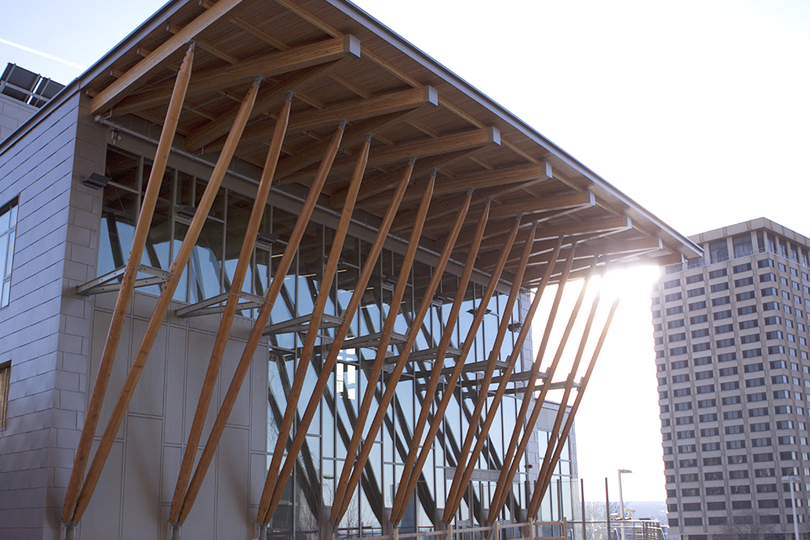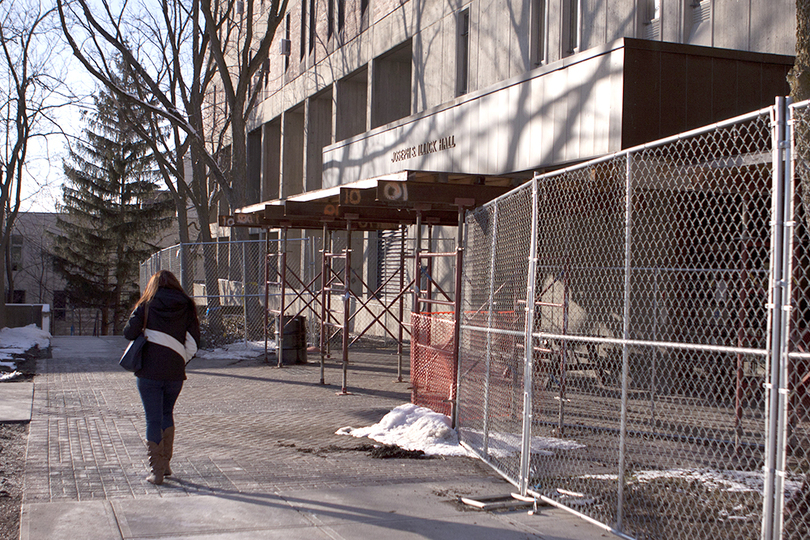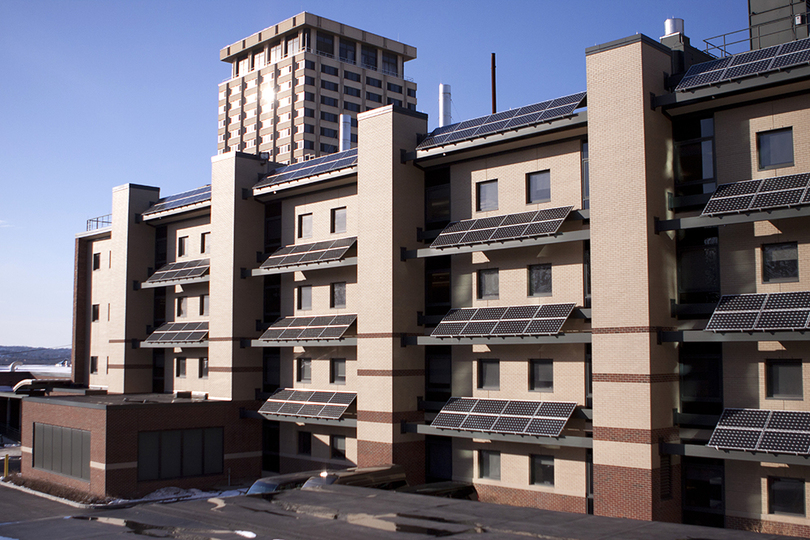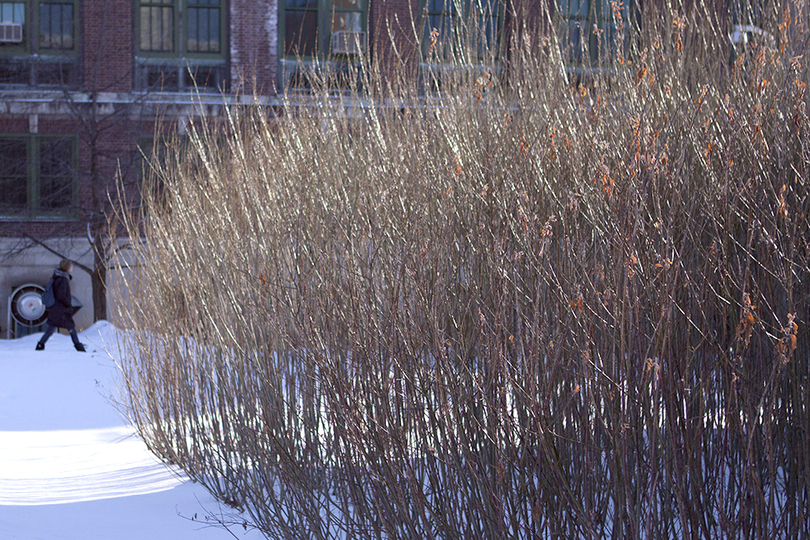It’s not easy being green: ESF officials, student organization work to achieve carbon neutrality by 2015
From solar panels appearing on rooftops to the clanking of construction workers making buildings more sustainable, SUNY-ESF’s progress toward becoming carbon neutral by 2015 is evident all across campus.
But this year, students and faculty involved with tracking the progress of the plan are hoping to engage more of the campus community in helping to achieve the goal of carbon neutrality.
“Creating a culture of sustainability takes a lot of time and a lot of work,” said Justin Heavey, a graduate student studying resource and forest management. “It’s less predictable than technological things, so I think that has been challenging and something we are still working at.”
Heavey is a member of the Campus Climate Change Committee, which includes students, faculty, staff and administrators who are helping ensure the State University of New York College of Environmental Science and Forestry meets its deadline. ESF President Cornelius Murphy signed the American College and University Presidents Climate Commitment in 2007, committing the school to the 2015 deadline.
Carbon neutrality involves offsetting greenhouse gas emissions by either running and operating renewable energy sources, or purchasing renewable energy from other institutions. ESF is currently working to become only the second college in the nation to achieve carbon neutrality by using only renewable energy sources, said Andrea Webster, a sustainability coordinator at ESF.
When Heavey was a junior in 2009, he and others helped create the Climate Action Plan, which outlines specific ways ESF can achieve climate neutrality by June 30, 2015. These measures mostly focused on ways ESF could change its buildings to become more energy efficient, particularly by installing new sources of renewable energy from wind, solar and a unique form of biomass, he said.
Although ESF has been progressively developing ways to make its buildings more sustainable, becoming carbon neutral requires difficult behavior changes for students and faculty, Heavey said. Some of these measures are harder to adapt to than others, such as using more energy-efficient transportation to get to and from the university.
But Heavey said some ESF student groups have been successful in encouraging eco-friendly habits outside of the classroom. The Green Campus Initiative, for example, has helped with some energy audits that were used to track ESF’s progress toward carbon neutrality, he said.
The audits completed by the Green Campus Initiative stemmed from its work removing unnecessary lighting around the ESF campus to save energy.Specifically, the group removed every other bulb from lights in Illick Hall, Heavey said.
Another source of renewable energy ESF is developing is woody biomass, Heavey said. This energy source, which is growing in popularity and efficiency, doesn’t produce air pollution since it has a very rapid life cycle, and can quickly store a lot of carbon dioxide and other pollutants.
A major element of ESF’s carbon neutrality plan is the Gateway building, which will run on woody biomass and emit zero waste once it opens in March, Heavey said.
President Murphy said once the Gateway building opens, it will have the largest near-term impact on helping ESF reach its carbon neutral goal.
The building will provide power and heat for many of the university’s other buildings from woody biomass, as well as reduce ESF’s overall reliance on less efficient forms of energy by about 60 percent, Murphy said.
“This project is a cornerstone to us becoming carbon neutral,” Murphy said.
For the last five years, ESF has reduced its carbon footprint by working with the New Yor Power Authority to add more photovoltaicsolar panels to the campus, such as those on the back of Baker Laboratory, Murphy said.
He added that ESF has added an average 25 kilowatts of photovoltaicper year.
Murphy also said although he announced last December that he will step down as president within a year, he does not think this will affect ESF’s goal of carbon neutrality.
“I would assume that given the passion of the students to reach carbon neutrality or get as close as we can, there is a very high probability we will continue down that path,” Murphy said. “There is nothing I am aware of that would change the plan.”
Murphy said ESF is a member of the American College and University Climate Commitment, an organization that promotes sustainability leadership among universities. ESF must submit yearly reports to this organization to ensure it is on the path to becoming carbon neutral.
Students in EST 427: “Environmental and Energy Auditing” class help create these yearly reports that are then presented to Murphy and ESF’s sustainability department, said Richard Smardon, the professor who teaches the class.
Students use a spreadsheet called Clean Air Cool Planet, and Mike Kelleher, the head of ESF’s sustainability and energy department, checks through the information the students have found, Smardon said.
Since 1999, one of the groups is designated to create a report that shows ESF’s progress toward completely counteracting its carbon footprint by 2015, Smardon said.
The amount of carbon dioxide ESF produced when the class first started doing the audits was more than 12,000 metric tons, Smardon said. The most recent audit done in 2012 shows that amount dropped to 11,451 metric tons, he said.
But ESF’s increasing enrollment has made reducing its carbon footprint more difficult during the past few years, Smardon said.
“The problem is that we have more and more students, so are not reducing by very much,” he said.
But Smardon said he thinks student groups on ESF’s campus such as the Green Campus Initiative have played a vital role in helping the university reduce its carbon footprint, despite its growing population. The area of personal behavior is one that his students often find hardest to measure and reduce in their calculations, he said.
“A lot of the movement, if you look around campus and the country, is among students pressuring faculty and administrations,” Smardon said.
Yusuf Abdul-Qadir, a graduate student studying sustainable enterprise, is in Smardon’s class, and is working with a group of five students to create the most recent report on ESF’s carbon footprint. He said, after analyzing previous reports, he found they seemed to lack information about students’ travel and behavioral patterns because many students neglected to take the surveys.
“In the last report, we found that there was not much student involvement and we find that highly important,” he said.
Abdul-Qadir said he and his teammates are hoping to get more students involved in ESF’s plan to become carbon neutral by filling out surveys about their behavior outside of academics, such as traveling to and from campus.
They have considered giving students incentives for filling out the surveys, such as hosting get-togethers with pizza and challenging them to meet benchmarks to change certain bad habits, he said.
Abdul-Qadir said his group has also considered making its findings about ESF’s carbon footprint more accessible to students on campus using new technology such as social media, and allowing students to fill out surveys on iPads for convenience.
“I think it’s phenomenal that a group of students is leading this project, and that as students, we can get other students involved in creative ways to show that young people are interested and have a stake in this,” Abdul-Qadir said. “You just need to find the right ways to engage them.”
Published on February 18, 2013 at 11:21 pm
Contact Shannon: smhazlit@syr.edu









